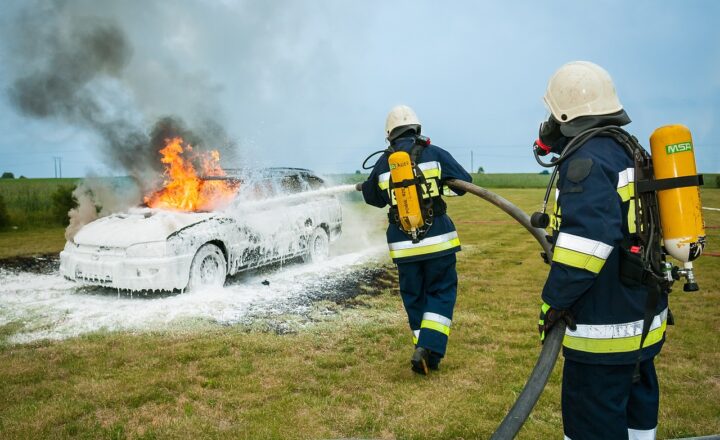How Firefighters Are Trained to Rescue Animals in Fires and Floods
November 13, 2024

Firefighters are known for their bravery and skill in saving human lives, but many are also trained to rescue animals in perilous situations. As natural disasters like fires and floods increase, the role of firefighters expands to include animal rescue, addressing the needs of pets and wildlife. This article delves into how firefighters are trained to rescue animals during such emergencies, ensuring that no life is left behind.
1. The Importance of Animal Rescue Training
Fires and floods pose significant threats to all living beings, not just humans. Animals, whether pets or wildlife, often find themselves trapped or injured during these disasters. Firefighters understand that rescuing animals is crucial not only for the animals’ sake but also for the emotional well-being of the community. The bond between humans and animals is profound, and by rescuing pets and wildlife, firefighters help restore hope and morale in a devastated community.
The importance of training firefighters in animal rescue cannot be overstated:
- Protecting Life: Every life counts, and trained firefighters can save many animal lives, promoting a sense of responsibility towards all creatures.
- Community Relations: Successfully rescuing animals strengthens the community’s trust in firefighters, showcasing their commitment to protecting all living beings.
- Reducing Liability: Proper training diminishes the chances of injury to both rescuers and animals, ensuring safer operations during chaotic situations.
2. Training Components for Firefighters in Animal Rescue
Firefighters undergo rigorous training that includes specialized techniques for handling animal rescues. This involves both physical and mental preparation to effectively deal with a variety of scenarios involving animals.
a. Understanding Animal Behavior
One of the first steps in training is to understand the behavior of different animals in distress. Animals can react unpredictably when frightened, which can pose a danger to both the animal and the rescuer. Firefighters learn about:
- Common signs of fear or aggression in various species.
- Methods to calm animals and prevent panic during rescue attempts.
- Strategies for safely approaching and handling injured or frightened animals.
b. Physical Rescue Techniques
Training also emphasizes physical techniques for rescuing animals. This can include:
- Using specialized equipment, such as rescue nets, traps, and ladders.
- Learning how to carry injured animals safely to prevent further injury or distress.
- Practicing rescue maneuvers in various environments like homes, forests, or flood zones.
c. Safety Protocols for Rescuers and Animals
Safety is paramount for both the firefighter and the animal. Trainees learn:
- How to protect themselves from potential bites or scratches during a rescue attempt.
- Use of protective gear when dealing with hazardous environments, such as floodwaters that may carry pollutants or wildlife with diseases.
- Setting up a safe perimeter around rescue sites to prevent chaos and ensure other first responders can work efficiently.
3. Real-Life Scenarios and Training Exercises
To prepare for unexpected situations, firefighters participate in realistic training exercises that simulate fires and floods. These exercises not only enhance technical skills, but also build teamwork and communication. Responding to an animal rescue during a live crisis can be chaotic, making prepared simulations essential.
Several training scenarios may include:
- Mock Flood Situations: Firefighters learn how to rescue animals when water levels rise, navigating swift currents while ensuring their own safety.
- Burning Structures: Simulated fires allow firefighters to practice entering homes to rescue trapped pets while handling smoke and flames safely.
- Wildlife Encounters: Training programs educate firefighters on how to handle wild animals trapped in urban settings after a disaster, focusing on species-specific approaches to rescue.
These scenarios ensure that firefighters do not just rely on textbooks but acquire real-life problem-solving skills that are unmatched in true emergencies.
4. Collaboration with Animal Rescue Organizations
To enhance their effectiveness, firefighters often collaborate with local animal rescue organizations and veterinary professionals. This partnership provides firefighters access to expertise when dealing with specific animal health concerns and rescue protocols.
Combined efforts can lead to:
- Better Preparedness: Training resources and information regarding local wildlife can be shared among organizations, leading to well-informed responders.
- Economical Resource Management: Collaborating with local shelters allows for a more efficient resource allocation during large-scale rescues.
- Enhanced Care for Rescued Animals: Immediate medical attention can be given to rescued pets through partnerships with veterinarians on the ground, improving survival rates.
5. Conclusion: Saving Lives Beyond Humans
The role of firefighters has evolved to include not just human safety but animal welfare as well. Through specialized training, firefighters are equipped to confidently and effectively carry out animal rescue operations in fires and floods. By understanding animal behavior, practicing physical rescue techniques, prioritizing safety, and collaborating with animal organizations, firefighters can ensure that both human and animal lives are preserved during disasters.
As natural disasters become more frequent, the need for trained professionals who can rescue both people and animals grows ever more critical. Firefighters are not just heroes for humans; they are guardians for all lives in peril, showcasing compassion and bravery in every life they save.
6. Helpful Resources
For those interested in learning more about animal rescue practices or getting involved, consider exploring the following resources:
- ASPCA: American Society for the Prevention of Cruelty to Animals – Offers guidelines and training for rescuers.
- NASAR: National Association for Search & Rescue – Provides resources on training in search and rescue operations.
- American Red Cross – Assists with disaster preparedness and recovery planning for pets.
This commitment by firefighters to animal rescue reflects a broader responsibility to all lives that depend on human action for safety during crises.







